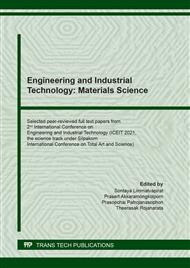p.141
p.149
p.155
p.163
p.169
p.175
p.181
p.187
p.193
Properties of Recycled Poly(Lactic Acid) Contaminated with Poly(Ethylene Terephthalate)
Abstract:
Poly(lactic acid) or PLA is one of the most important biodegradable plastics that replaces petroleum-based plastics for transparent disposable packaging. For circular economy, the accumulated PLA waste is required to recycle to produce high-quality recycled PLA grades. This research was aimed to simulate the influence of PET contamination (0.5, 1.0 and 2.0 wt%) on properties of the recycled PLA. Two grades of PLA; extrusion and injection molding, were used, and two temperature conditions (180 and 250°C) were used to evaluate the influence of mechanical recycling condition. Mechanical and thermal properties of the recycled PLA were investigated using tensile and impact testing, and differential scanning calorimeter, respectively. It was found that the mechanical recycling at 180°C produced the transparent specimens having unmolten white PET defects, which the mechanical properties were still intact with the PET contamination up to 1 wt%. The mechanical recycling at 250°C produced the opaque specimens with significantly lower mechanical properties due to the chain scission of PLA molecules, and the impact strength was slightly improved due to transesterification. The results could be used to emphasize the importance of the sorting step that the PLA recycling process should be performed with the PET contamination less than 1 wt%.
Info:
Periodical:
Pages:
181-186
Citation:
Online since:
March 2022
Keywords:
Price:
Сopyright:
© 2022 Trans Tech Publications Ltd. All Rights Reserved
Share:
Citation:


